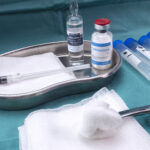
Infection with the spiral-shaped bacterium Treponema pallidum causes syphilis. Syphilis is a sexually transmitted infection (STI) that is contracted by having unprotected oral, anal, or vaginal sex with someone who has syphilis. It can also be transmitted to a fetus in the womb by an infected mother (congenital syphilis).
Syphilis does not get better on its own. It requires antibiotics (often penicillin) for treatment and cure. Without antibiotics, the infection can last a lifetime getting progressively worse. Antibiotics can cure syphilis at any stage. However, antibiotic treatment cannot undo the harm the disease has already done to major organ systems.
Timeline, stages, and symptoms of syphilis
Syphilis infection proceeds in 4 stages. A primary stage with the first symptoms is followed by a secondary stage with more pronounced symptoms. The infection can then go asymptomatic while continuing to spread in the body. This is called the latent stage of syphilis. After about 10-30 years, the disease manifests through problems with major organ systems. This is the tertiary stage of syphilis.
Other types of syphilis are neurosyphilis and congenital syphilis.
In neurosyphilis, the infection has spread to the spinal cord, the covering of the brain, or even the brain itself causing neurological problems.
Congenital syphilis is acquired by a child as a fetus or during birth from an infected mother.
Symptoms and timing of different syphilis stages
Primary syphilis
Timing
Symptoms usually begin 1-12 weeks after exposure but it can take up to 90 days
Symptoms
- A solitary painless ulcer called chancre at the site where the infection began, usually the genital area, anal area, or less frequently the mouth or throat.
- Swollen lymph nodes
Secondary syphilis
Timing
Symptoms usually begin 2-12 weeks after the appearance of the primary syphilis symptoms but can take as long as 6 months
Symptoms
- A rash that spreads all over the body including the palms of the hands and the soles of the feet.
- Fever
- Headache
- Body ache
- Malaise
- Patchy or diffuse loss of hair
- Fatigue
- Painful and swollen lymph nodes; more lymph nodes are affected than in primary syphilis
Early latent syphilis
Timing
Begins once symptoms from secondary syphilis die down. The patient has been asymptomatic for less than 1 year
Symptoms
This stage is asymptomatic
Late latent syphilis
Timing
Late latent syphilis is present when the patient has been asymptomatic for more than one year
Symptoms
This stage is asymptomatic
Tertiary syphilis
Timing
10-30 years after the initial infection
Symptoms
- Cardiovascular problems such as coronary artery disease
- Loss of hearing
- Loss of eyesight
- Neurological symptoms such as slurred speech, memory loss, altered behavior, and paralysis
- Formation of granulomatous lesions called gumma. They look like small tumors and gradually exude a gum-like substance from the center
Neurosyphilis
Timing
Any time during the infection
Symptoms
- Eye problems
- Hearing problems
- Headaches
- Dementia
- Personality changes
- Vertigo
- Problems with walking and balance
Early congenital syphilis
Timing
When syphilis is identified in the first two years of the child’s life
Symptoms
Two-thirds of the infections are asymptomatic. When present, symptoms include:
- Anemia
- Joint disorder
- Rhinitis (sniffles) with thick or bloody nasal discharge
- Enlarged liver and spleen
- Kidney problems
- Eye problems
- Neurological e.g. cerebrospinal fluid abnormalities
Late congenital syphilis
Timing
When syphilis is identified after the child’s second birthday
Symptoms
- Neurological problems
- Developmental defects
- Hutchinson’s triad (eye, teeth, and hearing problems)
Who is at risk of getting syphilis?
Anyone who is sexually active with individuals of unknown STI status can get syphilis. Both men and women are equally susceptible to getting infected by syphilis.
Risk behaviors that contribute to the rise of the spread of syphilis include:
- Having one or more sex partners who have syphilis or whose syphilis status is not known
- Having unprotected anal, oral, or vaginal sex (not using dental dams and condoms or not using them correctly)
- Having multiple sex partners
- Having a sex partner who has other concurrent sex partners
- Being a man who has sex with men. Gay, bisexual, and other men who have sex with men (MSM) are especially vulnerable to getting syphilis.
- Having sex under the influence of drugs or alcohol
- Exchanging sex for drugs or money
Some epidemiological factors can also have a role in increasing the spread of syphilis.
These include:
- Previous infection with syphilis or other STIs
- Being currently positive for HIV infection
- Being in communities where syphilis is endemic
- Having a history of homelessness or street involvement.
Testing for syphilis
Testing for syphilis is key to getting quick treatment and limiting the damage the disease does to the body. You may not have observed any symptoms or attributed symptoms to something else. Many people are surprised by their syphilis diagnosis. Therefore, periodic testing is recommended if you have an active sex life even if you don’t have any symptoms. How often you should get tested differs depending on your sexual practices.
The CDC recommends testing at least once a year if you are sexually active and every 3-6 months if you are at an increased risk of syphilis due to sexual behaviors or epidemiological reasons. Women who are pregnant or planning to be pregnant who are at risk of getting syphilis should get tested immediately and frequently during their pregnancy. The placenta can transmit the mother’s syphilis to the fetus as early as 9 weeks pregnant. For context, pregnant women have only missed 2 periods at this time, and many may not even know they are pregnant.
You can get tested for syphilis at a clinician’s office or an STD clinic. To find a location near you, visit
https://gettested.cdc.gov/
At-home tests are also available for testing yourself and your sex partners for STIs such as syphilis.
Syphilis treatment
The CDC recommends curing primary, secondary, and early latent syphilis by a single injection of long-acting Benzathine penicillin G. For late latent syphilis or latent syphilis of unknown duration, they recommend three doses of Benzathine penicillin G once a week for three weeks. Alternate antibiotics may be prescribed to those who have a penicillin allergy.
Longer antibiotic treatments are needed for tertiary syphilis and neurosyphilis. The treatment for neurosyphilis lasts for 14 days. The treatment of tertiary syphilis, late latent syphilis, and syphilis at any stage in an HIV-positive patient lasts for 3 weeks.
The information provided in our blog posts is for informational purposes only and is not intended as a substitute for professional medical advice, diagnosis, or treatment. Always seek the advice of your physician or other qualified health provider with any questions you may have regarding a medical condition. Never disregard professional medical advice or delay in seeking it because of something you have read on this blog.






